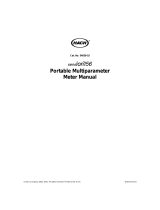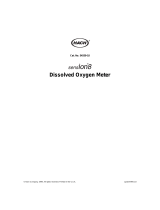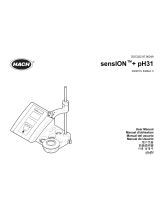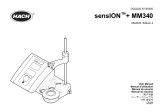
51750-18
Laboratory pH Meter
Instruction Manual
© Hach Company, 1999. All rights reserved. Printed in the U.S.A. hm/dk 3/99

2
AccuVac
®
ACS-Plus™
AgriTrak™
AluVer
®
AmVer™
APA 6000™
AquaTrend
®
BariVer
®
BiVer™
BoroTrace™
BODTrak™
BoroVer
®
CalVer
®
ChromaVer
®
CuVer
®
CyaniVer
®
Digesdahl
®
DithiVer
®
Dr. F. Fluent™
FerroVer
®
FerroMo™
FerroZine
®
Formula 2533™
Formula 2589™
Gelex
®
H
2
O University™
HachLink™
Hach.com™
Hach Logo
®
Hach One
®
Hach Oval
®
HexaVer
®
HgEx™
HydraVer
®
IncuTrol
®
LeadTrak
®
m-ColiBlue 24
®
ManVer
®
MercuVer
®
MolyVer
®
Mug-O-Meter
®
NTrak
®
NitraVer
®
NitriVer
®
OriFlo™
PathoScreen™
PbEx™
PermaChem
®
PhosVer
®
Pocket Colorimeter™
Pocket Turbidimeter™
Pocket Pal™
PourRite™
ProNetic™
Pump Colorimeter™
Rapid Liquid™
RapidSilver™
Ratio™
RegeneVer™
RoVer
®
Specê
StablCal™
StannaVer
®
StillVer
®
SulfaVer
®
Surface Scatter
®
TanniVer
®
TenSette
®
Test ’N Tube™
TitraStir
®
TitraVer
®
ToxTrak™
UniVer
®
VIScreen™
Voluette
®
WasteAway™
ZincoVer
®
TRADEMARKS OF HACH COMPANY

3
TABLE OF CONTENTS
CERTIFICATION ......................................................................................................................5
SPECIFICATIONS.....................................................................................................................9
SAFETY PRECAUTIONS ......................................................................................................10
OPERATION..........................................................................................................................11
SECTION 1 INTRODUCTION.......................................................................................13
1.1 Unpacking the Instrument..................................................................................................14
1.1.1 Standard Accessories................................................................................................14
1.2 Keypad Description............................................................................................................14
1.3 Display Fields and Icons....................................................................................................16
1.4 Audible Signals..................................................................................................................18
SECTION 2 INSTRUMENT SETUP.............................................................................19
2.1 Instrument Description.......................................................................................................19
2.2 Power Connection ..............................................................................................................19
2.3 Probe Connections..............................................................................................................20
2.3.1 Connecting pH Probes..............................................................................................20
2.3.2 Connecting the Temperature Probe ..........................................................................20
2.4 Printer and Computer Connections....................................................................................20
2.5 Turning the Meter On.........................................................................................................21
2.6 Temperature Measurement.................................................................................................21
2.7 Millivolt Measurements .....................................................................................................22
SECTION 3 INSTRUMENT OPERATION.................................................................23
3.1 Setup Menu ........................................................................................................................23
3.1.1 Choosing the Probe Connector.................................................................................23
3.1.2 Turning Display Lock Off and On............................................................................24
3.1.3 Selecting Temperature Units.....................................................................................24
3.1.4 Selecting Measurement Resolution ..........................................................................25
3.1.5 Selecting Auto Buffer Recognition...........................................................................25
3.1.6 Setting the Time........................................................................................................26
3.1.7 Setting the Month and Day.......................................................................................26
3.1.8 Setting the Year.........................................................................................................27
3.2 Calibrating the Meter .........................................................................................................27
3.2.1 Performing a Calibration Using pH 4, 6.86, 7, and 10 Buffers................................28
3.2.2 Calibrating With Other Buffers ................................................................................29
3.2.3 One-Point Calibration...............................................................................................30

4
TABLE OF CONTENTS, continued
3.3 Reviewing Calibrations......................................................................................................31
3.4 Measuring Samples............................................................................................................ 31
SECTION 4 STORING AND RECALLING DATA................................................... 33
4.1 Storing pH Measurements ................................................................................................. 33
4.2 Recalling Stored Data........................................................................................................ 34
4.3 Erasing Data....................................................................................................................... 34
4.3.1 Erasing Single Data Points....................................................................................... 34
4.3.2 Erasing All Data Points............................................................................................ 35
SECTION 5 PRINTING/TRANSFERRING DATA................................................... 37
5.1 Connecting To Printers/Computers.................................................................................... 37
5.1.1 Connecting With The RS232 Cable......................................................................... 37
5.1.2 Connecting To A Printer .......................................................................................... 37
5.1.3 Connecting to a Personal Computer......................................................................... 38
5.2 Sending Data to Printers/Computers.................................................................................. 40
5.2.1 Sending Currently Displayed Data........................................................................... 40
5.2.2 Sending Recalled Data Points.................................................................................. 40
5.2.3 Sending All Stored Data And The Average pH Value ............................................. 41
SECTION 6 TROUBLESHOOTING............................................................................. 43
6.1 Introduction........................................................................................................................ 43
6.2 Shorting Test...................................................................................................................... 43
6.3 Error Codes........................................................................................................................ 44
6.4 Meter Service Request Questionnaire................................................................................ 44
GENERAL INFORMATION ............................................................................................... 45
REPLACEMENT PARTS........................................................................................................ 47
HOW TO ORDER................................................................................................................... 49
REPAIR SERVICE ..................................................................................................................50
WARRANTY........................................................................................................................... 51

5
CERTIFICATION
Hach Company certifies this instrument was tested thoroughly,
inspected and found to meet its published specifications when it
was shipped from the factory.
The sens
ion™3 Laboratory pH Meter has been tested and is
certified as indicated to the following instrumentation standards:
Product Safety:
External Power Supplies Only:
115 VAC Supply: UL Listed and CSA certified or
230 VAC Supply: CE marked per 73/23/EEC, VDE listed
EMI Immunity:
Instrument tested with external 230V, 50 Hz power supply.
Per 89/336/EEC EMC: EN 61326:1998 (Electrical Equipment
for measurement, control, and laboratory use— EMC
requirements) Supporting test records by Hach Company,
certified compliance by Hach Company.
Standards include:
IEC 1000-4-2: 1995 (EN 61000-4-2:1995) Electro-Static
Discharge Immunity (Criteria B)
IEC 1000-4-3: 1995 (EN 61000-4-3:1996) Radiated RF
Electro-Magnetic Fields (Criteria B)
IEC 1000-4-4: 1995 (EN 61000-4-4:1995) Electrical Fast
Transients/Burst (Criteria B)
IEC 1000-4-5: 1995 (EN 61000-4-5:1995) Surge (Criteria B)
IEC 1000-4-6: 1996 (EN 61000-4-6:1996) Conducted
Disturbance Induced by RF Fields (Criteria A)
IEC 1000-4-11: 1994 (EN 61000-4-6:1994) Voltage Dips,
Interruptions and Variations (Criteria B)
ENV 50204:1996 Radiated Electro-Magnetic Field from
Digital Telephones (Criteria B)

6
CERTIFICATION, continued
Emissions:
Instrument tested with external 230V, 50 Hz power supply.
Per 89/336/EEC EMC: EN 61326:1998 (Electrical Equipment
for measurement, control, and laboratory use— EMC
requirements). Class B emission limits. Supporting test records
by Criterion Technology O.A.T.S. (NVLAP #0369), certified
compliance by Hach Company.
Standards include:
EN 61000-3-2 Harmonic Disturbances Caused by Electrical
Equipment
EN 61000-3-3 Voltage Fluctuations (Flicker) Disturbances
Caused by Electrical Equipment
Additional Standards include:
EN 55011 (CISPR 11) Emissions, Class B Limits
Additional Emissions Standard/s include:
CANADIAN INTERFERENCE-CAUSING EQUIPMENT
REGULATION, IECS-003: Class A emission limits.
Supporting test records by Criterion Technology O.A.T.S.
(NVLAP #0369), certified compliance by Hach Company.
This Class A digital apparatus meets all requirements of the
Canadian Interference-Causing Equipment Regulations.
Cet appareil numérique de la classe A respecte toutes les
exigences du Règlement sur le matériel brouilleur du Canada.
FCC PART 15, Class “A” Limits:
Supporting test records by Criterion Technology O.A.T.S.
(NVLAP #0369), certified compliance by Hach Company.
This device complies with Part 15 of the FCC Rules. Operation is
subject to the following two conditions:
(1) This device may not cause harmful interference, and (2) this
device must accept any interference received, including
interference that may cause undesired operation.

7
CERTIFICATION, continued
Changes or modifications to this unit not expressly approved by
the party responsible for compliance could void the user’s
authority to operate the equipment.
This equipment has been tested and found to comply with the
limits for a Class A digital device, pursuant to Part 15 of the FCC
Rules. These limits are designed to provide reasonable protection
against harmful interference when the equipment is operated in a
commercial environment. This equipment generates, uses, and
can radiate radio frequency energy and, if not installed and used
in accordance with the instruction manual, may cause harmful
interference to radio communications. Operation of this
equipment in a residential area is likely to cause harmful
interference, in which case the user will be required to correct the
interference at his own expense. The following techniques of
reducing the interference problems are applied easily.
1. Disconnect the external power supply from sens
ion3
Laboratory pH meter to verify that the meter is not the source
of interference.
2. Move the meter away from the device receiving the
interference.
3. Reposition the receiving antenna for the device receiving
the interference.
4. Try combinations of the above.

8

9
SPECIFICATIONS
Specification subject to change without notice.
pH mode
Range -2.00 to 19.99
Resolution (selectable) 0.001/0.01/0.1
Slope (meter allowable) 48–65 mV/decade
Millivolt mode
Range -2000 to 2000 mV
Resolution 0.1 mV
Accuracy (meter only) ±0.2 or ±0.05% of the reading,
whichever is greater
Temperature mode
Range -10.0 to 110 °C
(can also display °F)
Resolution 0.1 °C
Accuracy ±1.0 °C
Display: Custom LCD
Inputs: 1 BNC; 5-pin Hach pH/temperature or Hach temperature
probe; 1 pin-tip
Outputs: One-way RS232
Power Requirements: 6–12 Vdc; use either Hach-supplied 115
or 230V, 50/60 Hz external power supply or a customer-provided
supply with 50 mA output, 5.5-mm power plug with a 2.5 mm
center post opening.
Installation Category: II
Instrument Drift: <40 µV/°C
Input Bias Current: <±1 picoamp at 25 °C; ±4 picoamp over
full range
Environmental Requirements: 0 to 50 °C at 85% non-
condensing relative humidity
Dimensions: 15 x 25.4 x 8.37 cm (10.15 x 6 x 3.5 in.)
Enclosure: Water resistant (IP32), chemical resistant, dust proof.

10
SAFETY PRECAUTIONS
Section 2.2 on page 19
Section 2.3 on page 20
Section 2.4 on page 20
Section 5.1 on page 37

11
DANGER
Handling chemical samples, standards, and reagents can be dangerous. Review the necessary
Material Safety Data Sheets and become familiar with all safety procedures before handling
any chemicals.
DANGER
La manipulation des échantillons chimiques, étalons et réactifs peut être dangereuse. Lire les Fiches
de Données de Sécurité des Produits (FDSP) et se familiariser avec toutes les procédures de sécurité
avant de manipuler tous les produits chimiques.
PELIGRO
La manipulación de muestras químicas, estándares y reactivos puede ser peligrosa. Revise las fichas
de seguridad de materiales y familiarícese con los procedimientos de seguridad antes de manipular
productos químicos.
GEFAHR
Da das Arbeiten mit chemischen Proben, Standards und Reagenzien mit Gefahren verbunden ist,
empfiehlt die Hach Company dem Benutzer dieser Produkte dringend, sich vor der Arbeit mit
sicheren Verfahrensweisen und dem richtigen Gebrauch der Chemikalien vertraut zu machen
und alle entsprechenden Materialsicherheitsdatenblätter aufmerksam zu lesen.
PERIGO
A manipulação de amostras, padrões e reagentes químicos pode ser perigosa. Reveja a folha dos
dados de segurança do material e familiarize-se com todos os procedimentos de segurança antes
de manipular quaisquer produtos químicos.
OPERATION

12

13
SECTION 1 INTRODUCTION
Hach provides pH and ISE meters for applications from pH
measurements to accurate Ion Selective Electrode work. This
manual describes the operation and use of the Hach sens
ion
™
3
Laboratory pH/mV/Temperature Meter (see Figure 1).
This meter features a custom digital LCD display which
simultaneously displays temperature and measurement results.
This meter has all the features of a pH meter plus a millivolt
mode, water resistant design, ergonomic design, and automatic
buffer recognition. Additional features include datalogging and
RS232 communication for printing results to a computer
or printer.
The meter is designed to be maintenance-free. If the meter gets
dirty, wipe the surface with a damp cloth. Use a cotton-tipped
applicator to clean or dry the connectors if the they get wet.
Figure 1 Hach
sens
ion3
Meter

14
SECTION 1, continued
1.1 Unpacking the Instrument
Remove the instrument and accessories from the shipping
container and inspect each item for any damage that may have
occurred during shipping. Verify that all items listed on the
packing slip are included. If any items are missing or damaged,
contact Hach Customer Service, Loveland, Colorado for
instructions. Hach’s toll free phone number for customers within
the United States is 800-227-4224. For customers outside the
United States, contact the Hach office or distributor serving you.
1.1.1 Standard Accessories
• AC to DC adapter
• Instrument Manual
• May contain electrode and related accessories (covered in the
electrode manual)
1.2 Keypad Description
Figure 2 illustrates the meter’s keypad. The description and
function of each key is given in Table 1.
Figure 2
sens
ion3
pH Meter Keypad

15
SECTION 1, continued
Table 1 Keys and Description
Key Description
Exit/Power On-
Off
Turns the instrument on; turns it off from a Reading mode.
Acts as a NO or Cancel key when the question mark icon is flashing.
Exits setup function or aborts a setup change.
Performs the following and returns to the most recent Reading mode:
• Exits the Store or Recall mode
• Aborts a calibration
• Exits a calibration review
Arrow Keys Scrolls between options in Setup mode.
Scrolls through data points in Store and Recall modes.
Scrolls between the option to print or erase one data point and all data points.
Changes the default temperature when a temperature probe is not in use.
READ/ENTER
Key
Acts as a “YES” answer when the question mark is flashing.
Allows user to edit a setup when the setup number is flashing.
Accepts a change to the current Setup option.
Initiates a new measurement when the meter has stabilized in the Display Lock
Enabled mode.
Recall Key Recalls stored sample data (from Reading mode only).
Store Key Stores the current (displayed) measurement (from Reading mode only).
Erase Key Erases recalled data points.
pH/mV Key Toggles between pH value and mV value in Reading, Calibration, and Cal
Review modes.
Print Key Sends current or recalled data to a printer or a computer via the RS232 port.
Average Key Calculates the average of all the stored pH readings. Any stored ISE readings
are ignored.
Time Key In Reading mode, allows user to view the current time and date. In Recall Data
mode, it toggles between the time and date of the stored measurement.
Cal Key Enters Calibration mode (from Reading mode only)
Review Key Enters Calibration Review mode (from Reading mode only)
Setup/CE Key Enters Setup mode (from Reading mode only) or clears a numeric entry when the
keypad icon is displayed.

16
SECTION 1, continued
1.3 Display Fields and Icons
The display has two screens. The upper screen displays
measurements or standard values, the operation mode in use,
slope, sample/default temperature, pH or mV units, error codes,
and indicates if the meter reading is stable. The lower screen
displays the keys that are active.
Figure 3 shows the icons and fields displayed by the meter and
Table 2 describes each element. Some icons on the display are not
used by the laboratory pH sens
ion3 meter, but will be displayed
if the power key is held down for several seconds.
Figure 3 sensION 3 Display Elements

17
SECTION 1, continued
Table 2 Main Display Elements
Item No. Description
1 Indicates meter is in Calibration mode. If the ? is flashing, it indicates calibration is
necessary.
2 Indicates meter is in Calibration Review mode.
3 Indicates data is being sent to a printer/computer.
4 Indicates recalled data that is currently displayed is being erased.
5 Indicates meter is in Setup mode.
6 Indicates all data points are being printed or erased.
7 Numerical field that displays Setup, Sample.pH average, and Standard numbers when
those words are displayed with the number. If
Standard and 1 are displayed, the meter is
measuring Standard 1.
8 Flashing
? and CAL indicate calibration is necessary. Also a prompt to press the ENTER or
EXIT key.
9 Indicates the meter is measuring a sample (sample number is displayed to the right).
10 Indicates the meter is measuring a standard (standard number is displayed above).
11 Indicates the displayed number is the electrode slope.
12 Numerical field that displays the slope and pH or mV values of standards and samples.
13 Indicates measurement units (pH or mV).
14 When
Default is displayed, the meter is using the default temperature value to calculate the
temperature correction for the pH value.
15 Temperature units (choice of °C or °F).
16 Indicates value displayed in small numerical field (item 17) is in millivolts.
17 Numerical field that displays temperature value, or pH offset in Calibration Review.
18 Indicates meter is using AC power.
19 Indicates an inactive key has been pressed and that function is not allowed.
20 Indicates ENTER key is active.
21 Indicates arrow keys are active.
22 In Setup mode, it indicates the date is being set.
23 Indicates EXIT key is active.
24 NA
25 Indicates numeric part of the key is active.
26 Display Lock icon. Displayed with item 27.
27 Indicates whether Display Lock is
On or Off.
28 Faulty probe connection or incorrect probe attached. Usually displayed with an error code.
May also indicate a low slope.
29 NA (low battery icon)
30 Indicates a meter function problem.

18
SECTION 1, continued
1.4 Audible Signals
The meter will beep under certain conditions:
• when a non-functional key press is made (one beep).
• when display lock is enabled and measurement stability is
reached in calibration and reading mode (three beeps).
• any time measurement stability is reached during calibration
mode, regardless of the Display Lock setting.
• when an inappropriate standard value is entered
during calibration.
• to signal an error condition.
If the number entry and a press of the
ENTER key causes two
beeps, the meter will automatically return to the beginning of
number entry.
31 Stabilizing... indicates signal from sample is not yet stable. When it disappears, the
reading is stable and may be recorded or stored.
32 Used with ? icon. Asking if user wants to store the displayed sample data or the calibration
that has been just completed.
33 Used with large display to indicate the time is being set.
34 Indicates meter is in recall mode and the data displayed is stored data.
Table 2 Main Display Elements (Continued)
Item No. Description

19
SECTION 2 INSTRUMENT SETUP
2.1 Instrument Description
This sension
™
3 benchtop pH/mV meter is designed for
laboratory use and operates on 115 or 230 VAC power. The meter
measures from -2.0 to 19.99 pH units and the sample
temperature. Displayed pH values are temperature corrected
using the measured sample temperature or a default temperature
setting. The meter also measures and displays mV. To toggle
between pH and mV readings, press the
pH/mV key.
2.2 Power Connection
A 115 or 230 VAC pin adapter connects the meter to line power.
Plug the pin end of the adapter into the pin connector in the meter
(see Figure 4). Then plug the adapter into the outlet.
Figure 4
sens
ion3
Power and Probe Connections

20
SECTION 2, continued
2.3 Probe Connections
2.3.1 Connecting pH Probes
Attach electrodes with 5-pin connectors to the sensor input by
lining the pins up with the holes in the meter port (see Figure 4).
Push toward the instrument.
For probes with BNC connectors, slide the connector into the
input. Push towards the instrument and turn clockwise to lock
into position.
Electrodes may be attached to both the 5-pin and BNC connectors
at the same time as long as they are not in contact with the same
solution. To select either of the connectors for measurement, go
to the
Setup 1 menu and select one.
When using half-cells, connect reference electrodes with pin tip
connectors by pushing the connector straight into the center
reference input.
Note: If using a combination electrode with a BNC or 5-pin connector,
the reference pin-tip jack is not used.
2.3.2 Connecting the Temperature Probe
Hach electrodes with the 5-pin connector have the temperature
sensing unit included in the electrode probe. If using an electrode
with BNC connector, connect a Hach temperature probe to the
5-pin connector. Alternatively, measure the temperature manually
and enter the value as the default temperature on the meter.
2.4 Printer and Computer Connections
The meter can send data to a computer or printer via the 9-pin
serial port (see Figure 4). The printer cable and computer
cable are different. The printer cable is a 9-pin to 25-pin cable
and the computer cable is a 9-pin to 9-pin cable. Be sure to use
the correct cable.
The meter can print to serial printers without an adapter. For
parallel printers, a converter and cable adapter are required. The
Citizen PN60 printer (Cat. No. 26687-00) requires a special
Citizen adapter. Pressing the
PRINT key will send the currently
Page is loading ...
Page is loading ...
Page is loading ...
Page is loading ...
Page is loading ...
Page is loading ...
Page is loading ...
Page is loading ...
Page is loading ...
Page is loading ...
Page is loading ...
Page is loading ...
Page is loading ...
Page is loading ...
Page is loading ...
Page is loading ...
Page is loading ...
Page is loading ...
Page is loading ...
Page is loading ...
Page is loading ...
Page is loading ...
Page is loading ...
Page is loading ...
Page is loading ...
Page is loading ...
Page is loading ...
Page is loading ...
Page is loading ...
Page is loading ...
Page is loading ...
Page is loading ...
/












